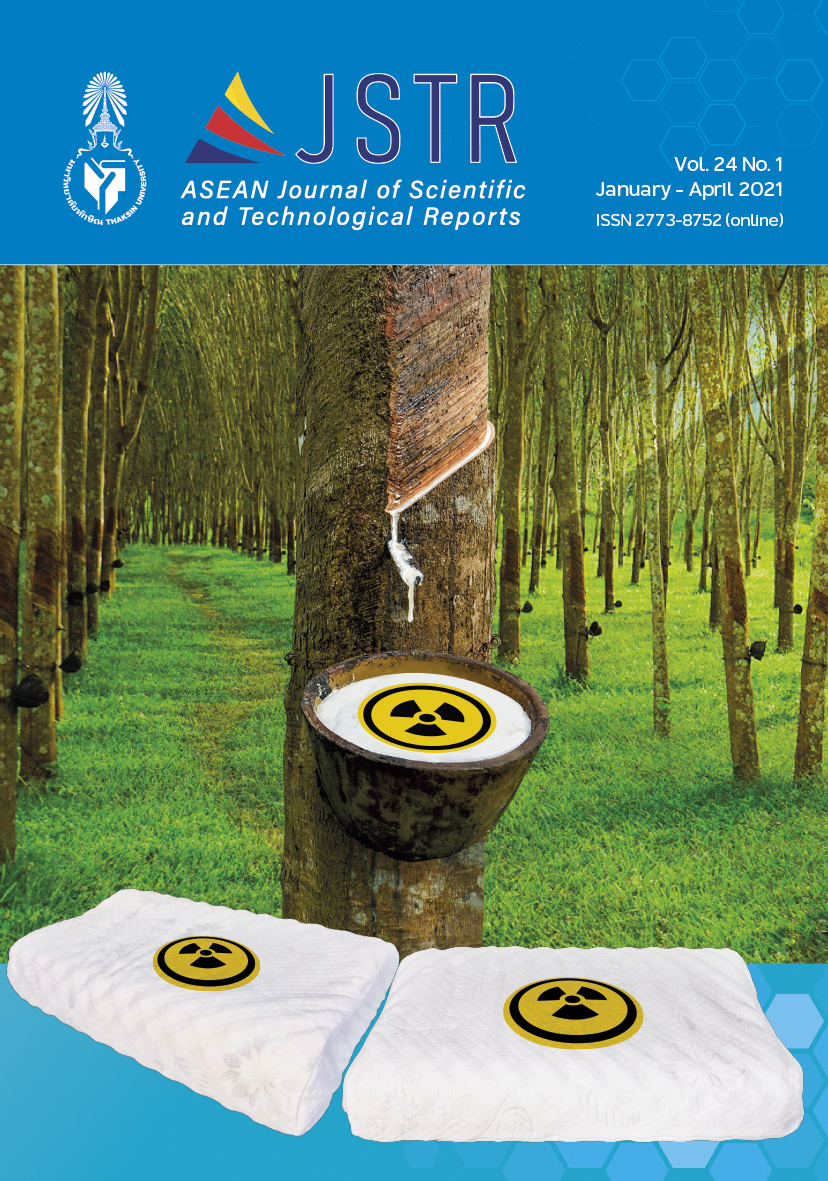Total Phenolic Content, Antioxidant and Antityrosinase Activities of Garcinia dulcis Root Extract
Main Article Content
Abstract
The objective of this study is to investigate total phenolic content, antioxidant and antityrosinase activities of G.dulcis root extract and fractions (A-J). It found that the total phenolic content of the crude extract was 338.42 ± 6.08 mg GAE/g extract. The extract showed good activity against DPPH (IC50 71.07 ± 0.02 μg/ml), ABTS (IC50 28.08 ± 0.01 μg/ml) and good ferric reducing antioxidant power (235.40 ± 3.44 mg AAE/g extract). It also showed inhibitory activity toward tyrosinase enzyme (IC50 354.15 ± 0.13 μg/ml). Fractions E and I showed better activity than the extract and other fractions in all tested. 12b-hydroxy-des-D-garcigerin A and globuxanthone are major components from fraction E and symphoxanthone was obtained from fraction I. The result indicated that fraction from G.dulcis root extract is a natural antioxidant and antityrosinase source with potential for use as active ingredients in cosmetics.
Article Details

This work is licensed under a Creative Commons Attribution-NonCommercial-NoDerivatives 4.0 International License.
References
El-Abaseri, T. B., Hammiller, B., Repertinger, S. K., & Hansen, L. A. (2013). The epidermal growth factor receptor increases cytokine production and cutaneous inflammation in response to ultraviolet irradiation. ISRN Dermatology, 2013, 848705. DOI: 10.1155/2013/ 848705.
Thepthong, P., Phongpaichit, S., Carroll, A. R., Voravuthikunchai, S. P., & Mahabusarakam, W. (2017). Prenylated xanthones from the stem bark of Garcinia dulcis. Phytochemistry Letters, 21, 32–37. DOI: 10.1016/j.phytol.2017.05.014.
Iinuma, M., Tosa, H., Ito, T., Tanaka, T., & Riswan, S. (1996). Three new benzophenone-xanthone dimers from the root of Garcinia dulcis. Chemical and Pharmaceutical Bulletin, 44(9), 1744–1747. DOI:10.1248/cpb.44.1744.
Iinuma M., Ito, T., Tosa, H., Tanaka, T., & Riswan, S. (1996). Five new xanthones from Garcinia dulcis. Journal of Natural Products, 59(5), 472–475. DOI: 10.1021/np960340r.
Thepthong, P. (2017). Xanthones and other phenolics from the stem bark of Garcinia dulcis with antioxidative and antibacterial activities. Doctoral Dissertation, Prince of Songkla University.
Chang, L. W., Juang, L. J., Wang, B. S., Wang, M. Y., Tai, H. M., Hung, W. J., Chen, Y. J., & Huang, M. H. (2011). Antioxidant and antityrosinase activity of mulberry (Morus alba L.) twigs and root bark. Food and Chemical Toxicology, 49(4), 785–790. DOI: 10.1016/ j.fct.2010.11.045.
Nagendra Prasad, K., Yang, B., Yang, S., Chen, Y., Zhao, M., Ashraf, M., & Jiang, Y. (2009). Identification of phenolic compounds and appraisal of antioxidant and antityrosinase activities from litchi (Litchi sinensis Sonn.) seeds. Food Chemistry, 116(1), 1–7. DOI: 10.1016/j.foodchem.2009.01.079.
Deachathai, S., Mahabusarakam, W., Phongpaichit, S., & Taylor, W. C. (2005). Phenolic compounds from the fruit of Garcinia dulcis. Phytochemistry, 66(19), 2368–2375. DOI:10.1016/j.phytochem.2005.06.025.
Deachathai, S., Mahabusarakam, W., Phongpaichit, S., Taylor, W. C., Zhang, Y. J., & Yang, C. R. (2006). Phenolic compounds from the flowers of Garcinia dulcis. Phytochemistry, 67(5), 464–469. DOI: 10.1016/j.phytochem.2005.10.016.
Deachathai, S., Phongpaichit, S., & Mahabusarakam, W. (2008). Phenolic compounds from the seeds of Garcinia dulcis. Natural Product Research, 22(15), 1327–1332.DOI: 10.1080/14786410601130406.
Singleton, V. L., Orthofer, R., & Lamuela-Raventós, R.M. (1999). [14] Analysis of total phenols and other oxidation substrates and antioxidants by means of folin-ciocalteu reagent. Methods in Enzymology, 299, 152–178. DOI: 10.1016/S0076-6879(99)99017-1.
Manok, S., & Lincharoen, P. (2015). Investigating antioxidant activity by DPPH, ABTS and FRAP assay and total phenolic compounds of herbal extracts in Ya-Hom Thepphachit. Advanced Science, 15(1), 106–117.
Re, R., Pellegrini. N., Proteggente, A., Pannala, A., Yang, M., & Rice-Evans, C. (1999). Antioxidant activity applying an improved ABTS radical cation decolorization assay. Free Radical Biology & Medicine, 26(9-10), 1231–1237. DOI: 10.1016/s0891-5849(98)00315-3.
Benzie, I. F., & Strain, J. J. (1996). The ferric reducing ability of plasma (FRAP) as a measure of “antioxidant power”: the FRAP assay. Analytical Biochemistry, 239(1), 70–76. DOI:10. 1006/abio.1996.0292.
Alam, N., Yoon, K. N., & Lee, T. S. (2011). Evaluation of the antioxidant and antityrosinase activities of three extracts from Pleurotus nebrodensis fruiting bodies. African Journal of Biotechnology, 10(11), 2978–2986. DOI: 10.5897/AJB10.2660.
Pancoke, J., Kerdchoechuen, O., & Laohakunjit, N. (2012). Antioxidant capacity and total phenolics of 3 plant extracts. Agricultural Science Journal, 43(2)(suppl.), 381–384.
Gogoi, N., Gogoi, A., Neog, B., Baruah, D., & Singh, K. D. (2017). Evaluation of antioxidant and hepatoprotective activity of fruit rind extract of Garcinia dulcis (Roxburgh) Kurz. Pharmacognosy Research, 9(3), 266–272. DOI: 10.4103/0974-8490.210330.
Ito, S., & Wakamatsu, K. (2008). Chemistry of mixed melanogenesis-pivotal roles of dopaquinone. Photochemistry and Photobiology, 84(3), 582–592. DOI: 10.1111/j.1751-1097.2007.00238.x


